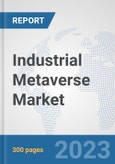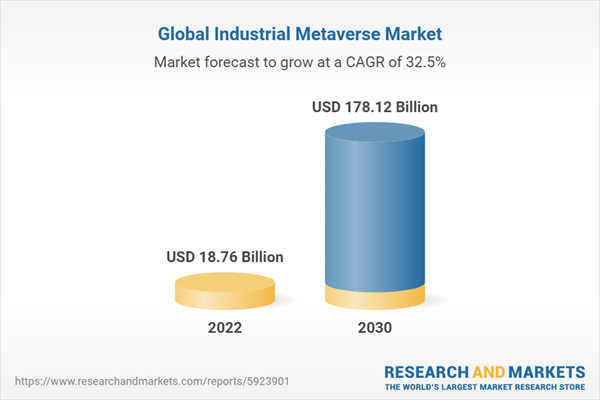The industrial metaverse is revolutionizing business operations by creating virtual, interconnected environments that enhance collaboration, innovation, and productivity in industrial sectors. This immersive digital realm combines Augmented Reality (AR) and Virtual Reality (VR) technologies to simulate real-world industrial processes, training scenarios, and product designs. In this dynamic metaverse, businesses can optimize operational workflows, conduct virtual training sessions, and simulate complex manufacturing processes. The industrial metaverse enables seamless collaboration among teams dispersed globally, fostering innovation and efficiency. The continual digital transformation of global industries is substantially driving the growth of the industrial metaverse market. The key players are increasingly exploring methods to incorporate and visualize data, streamline processes, and improve collaboration by utilizing technologies like IoT, AI, VR, and Augmented Reality (AR). Along with this manufacturing is embracing this transformative technology to gain a competitive edge through accelerated decision-making, reduced downtime, and improved workforce skills.
The primary driver for the industrial metaverse is the pursuit of enhanced operational efficiency through immersive digital technologies. Industries are leveraging the metaverse to simulate and optimize complex processes, facilitate remote collaboration, and train personnel in realistic virtual environments. This drive is fuelled by the need to reduce costs, minimize downtime, and enhance overall productivity. The industrial metaverse acts as a transformative tool, enabling businesses to visualize, analyze, and streamline their operations in ways previously unattainable. The quest for heightened efficiency and competitiveness in a rapidly evolving digital landscape is steering industries toward embracing the potential of the industrial metaverse. Additionally, the rise in the adoption of digital twin technologies is driving the growth of the industrial metaverse market. The industrial metaverse represents the seamless integration of digital and physical realms, where humans, machines, data, and processes interact in real-time across virtual and physical environments. Within this context, digital twins serve as dynamic counterparts to real-world systems, processes, and assets. Digital twin technology involves creating virtual representations of physical objects or systems, enabling modelling, design, analysis, and optimization. The widespread popularity of this technology can be attributed to advancements in Artificial Intelligence (AI), the Internet of Things (IoT), Extended Reality (ER), and cloud computing. However, limited standardization and interoperability pose a restraint for the industrial metaverse market. Moreover, the development and implementation of advanced real-time monitoring and analytics systems across a single line of production creates an opportunity for growth in the market.
North America is projected to hold the most prominent market share in the upcoming forecast period. North America has been a dominant force due to its strong technological infrastructure, substantial investments in industrial innovation, and a robust ecosystem of tech companies. The presence of major industrial players, coupled with a proactive approach toward adopting emerging technologies, positions North America at the forefront of the industrial metaverse market. Furthermore, The Asia-Pacific region is the fastest-growing industrial metaverse market, driven by a convergence of factors. Robust technological infrastructure development, a burgeoning manufacturing sector, and proactive government initiatives in countries like China, Japan, and South Korea contribute to the region's accelerated adoption. Additionally, the increasing demand for operational efficiency, cost savings, and innovation in industries such as automotive, electronics, and healthcare fuels the rapid expansion of the industrial metaverse. This growth is further propelled by a dynamic workforce, fostering a conducive environment for the integration of virtual and physical industrial processes.
Report Findings
1) Drivers
- The pursuit of enhanced operational efficiency through immersive digital technologies is driving the growth of the industrial metaverse market.
- The rise in the adoption of digital twin technologies is driving the growth of the industrial metaverse market.
2) Restraints
- Limited standardization and interoperability pose a restraint for the industrial metaverse market.
3) Opportunities
- The development and implementation of advanced real-time monitoring and analytics systems across a single line of production creates an opportunity for growth in the market.
Research Methodology
A) Primary Research
The primary research involves extensive interviews and analysis of the opinions provided by the primary respondents. The primary research starts with identifying and approaching the primary respondents, the primary respondents are approached include1. Key Opinion Leaders associated
2. Internal and External subject matter experts
3. Professionals and participants from the industry
The primary research respondents typically include
1. Executives working with leading companies in the market under review2. Product/brand/marketing managers
3. CXO level executives
4. Regional/zonal/ country managers
5. Vice President level executives.
B) Secondary Research
Secondary research involves extensive exploring through the secondary sources of information available in both the public domain and paid sources. Each research study is based on over 500 hours of secondary research accompanied by primary research. The information obtained through the secondary sources is validated through the crosscheck on various data sources.The secondary sources of the data typically include
1. Company reports and publications2. Government/institutional publications
3. Trade and associations journals
4. Databases such as WTO, OECD, World Bank, and among others.
5. Websites and publications by research agencies
Segment Covered
The global industrial metaverse market is segmented on the basis of component, technology, application, and end-use.The Global Industrial Metaverse Market by Component
- Software
- Hardware
- Service
The Global Industrial Metaverse Market by Technology
- AR
- VR
- MR
The Global Industrial Metaverse Market by Application
- Product Design & Development
- Virtual Prototyping
- Training & Simulation
- Remote Collaboration
- Maintenance & Repair
- Supply Chain Optimization
- Data Visualization & Analytics
The Global Industrial Metaverse Market by End-use
- Automotive
- Logistics & Transportation
- Manufacturing
- Energy and Utilities
- Healthcare
- Others
Company Profiles
The companies covered in the report include- Microsoft Corporation
- Bentley Systems, Inc.
- Dassault Systems SE
- HTC Corporation
- NVIDIA Corporation
- PTC Inc
- Siemens AG
- Unity Software Inc.
- Schneider Electric group.
- GE DIGITAL
What does this Report Deliver?
1. Comprehensive analysis of the global as well as regional markets of the industrial metaverse market.2. Complete coverage of all the segments in the industrial metaverse market to analyze the trends, developments in the global market and forecast of market size up to 2030.
3. Comprehensive analysis of the companies operating in the global industrial metaverse market. The company profile includes analysis of product portfolio, revenue, SWOT analysis and latest developments of the company.
4. Growth Matrix presents an analysis of the product segments and geographies that market players should focus to invest, consolidate, expand and/or diversify.
Table of Contents
Companies Mentioned
- Microsoft Corporation
- Bentley Systems, Inc.
- Dassault Systems SE
- HTC Corporation
- NVIDIA Corporation
- PTC Inc
- Siemens AG
- Unity Software Inc.
- Schneider Electric group.
- GE DIGITAL
Table Information
| Report Attribute | Details |
|---|---|
| No. of Pages | 300 |
| Published | December 2023 |
| Forecast Period | 2022 - 2030 |
| Estimated Market Value ( USD | $ 18.76 Billion |
| Forecasted Market Value ( USD | $ 178.12 Billion |
| Compound Annual Growth Rate | 32.5% |
| Regions Covered | Global |
| No. of Companies Mentioned | 10 |









